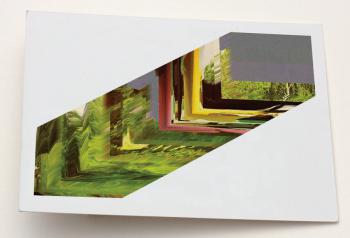“Carpets Curtains” is originally the title for a live performance project by Ivan Palacký (sound) and Filip Cenek (image), who started their collaboration already in 2003. The exhibition at Školská 28 Gallery is their second attempt to transfer such synergy of improvised and abstract sounds and images into the gallery space - or rather into the “fine art” context. (The first event was held a year ago at The Good Shepherd Gallery in Brno.)
The exhibition is divided into two parts: the first one documents, or rather, exposes the deconstruction of their live performance into partial audio and video modules which elaborate the process of converting the concrete samples of sound and video into abstract forms. The second part of the installation is entitled “The Junction”, a new installation based on a database of sentences of constantly changing order, ripped out of context and then returned to it - a practice which is typical for Cenek and Palacký from the beginning of their collaboration.
Can technology be a secret? If so, it is needless to attempt explaining how both artists create their “carpets and curtains” and how works in this case a “junction”, which can be perceived as simple metaphors for the methodology of their visual and audio “trajectories”. Is it appropriate to not interfere with the viewer’s intuition and not to offer a precise interpretation? Because a fascination with the technical solution, if this was not conceived with self-reflection, turns our attention to the technological apparatus as a quality of exactitude. From “how it looks” to “how it operates” we finally get to, “how it really functions”. The layman’s alibi? I’d rather stay with the vague statement that the sequences of images displayed from a slide projector,together with the sound component, are not created from the aesthetic point of view or from some other artistic intent, but are made by the “apparatus?”. (Labelling it an apparatus refers to the mythical juxtaposition of machine vs. human.) The defining principle of selection and sequencing is machine-generated randomness, similar to the order of winning lottery numbers.
Cenek and Palacký’s two-channel installation creates a tension between the “banality” of the rotating mechanism of the carousel slide projector and the technology behind the scenes, which itself manages to produce visual and audio tracks. More specifically: a noisy projector of moving images, whose function is to display still photographs and texts, and which is controlled by software. Sequential images are simultaneously “quasi- cinematic”, with a clear alusion to the canonical film La Jetée by Chris Marker from 1962. Instead of envisioning the end of the world and of memories of travel, Cenek and Palacký's narrative is simply marked by chance and controlled by the machine.
Also present is a popular link to early cinema in the context of digital effects. The acyclic random order of slides means that each time, we may see a new version of the installation, an unique experience.
Paradoxically, the apparatus brings a performative aspect to the installation. To put it in stark terms, it brings aura back to the original.
Marika Kupková, curator
A part of the exhibition project is the live audiovisual performance at The Babel Prague festival Soundexchange Day program, where Palacký and Cenek work with sound and continuous light - a live stereo slide projector performance controlled by fotovoltaic panels. The concert is held at Archa Theatre 5th October, and the duo is performing together with the pianist Peter Graham.
The exhibition is part of the international project Soundexchange and Babel Prague Festival
SOUND EXCHANGE is a project by DOCK e.V. Berlin and Goethe Institut funded by the German Cultural Foundation Produced in cooperation with Goethe Institut Prag, Babel Festival, Archa Theatre, Komunikační prostor Školská 28 and Asociace MLOK.










